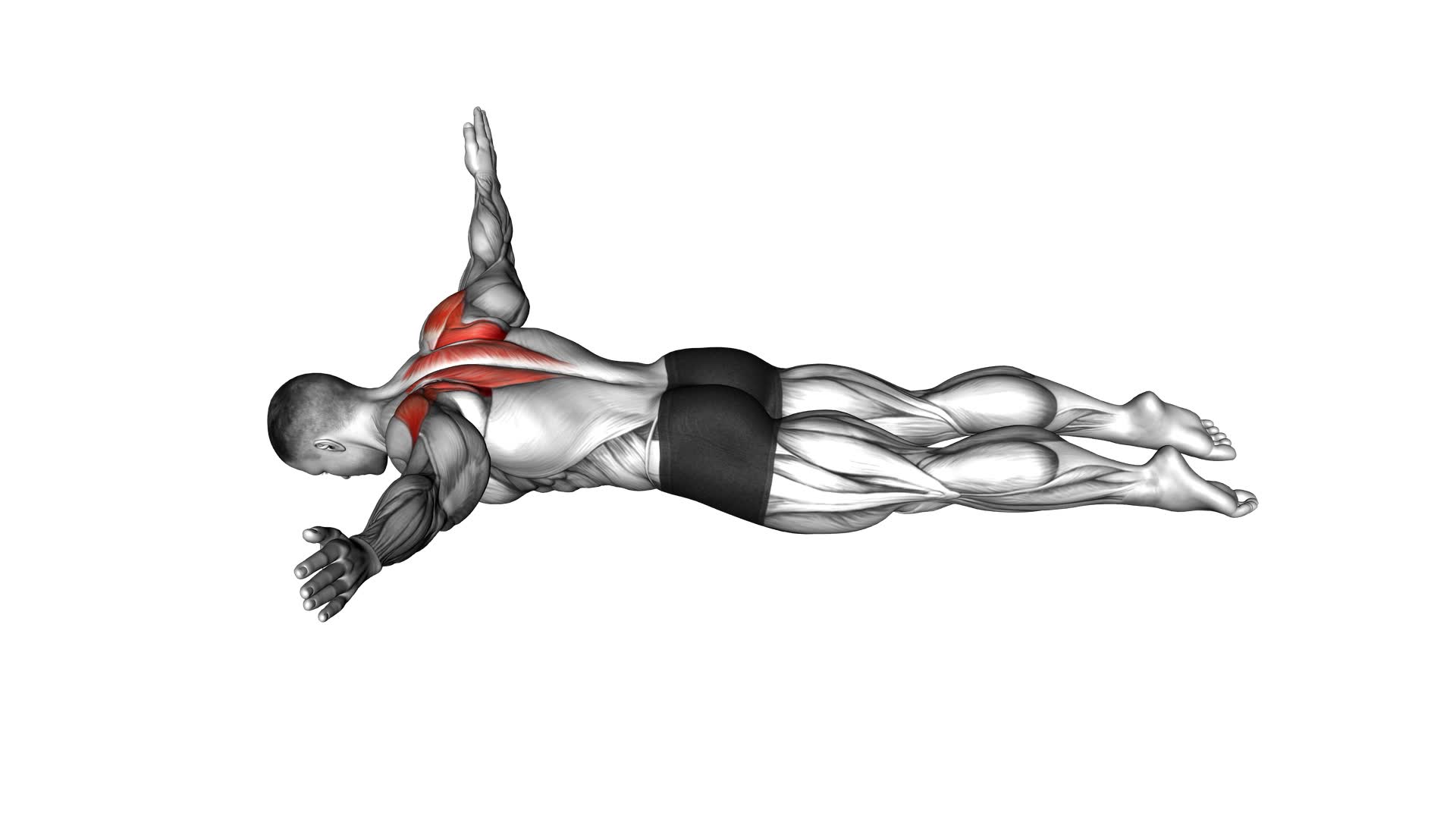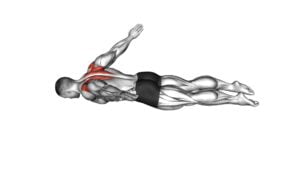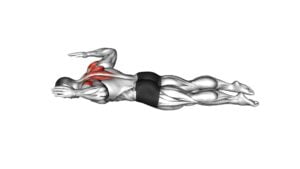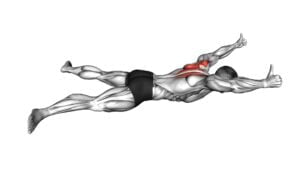Lying Prone W to T – Video Exercise Guide & Tips

If you're looking to strengthen your back and improve your posture, the Lying Prone W to T exercise is a must-try.
Watch This Exercise Video
In this video exercise guide, we'll show you the proper form and technique for this effective exercise.
With just a few minutes a day, you can reap the benefits of a stronger back and improved posture.
Get ready to feel the burn and see the results with this simple yet powerful exercise.
Key Takeaways
- Lying Prone W to T exercise targets upper back muscles and improves posture
- Proper form and technique, such as engaging the core and avoiding shrugging shoulders, is important for maximizing benefits and preventing injury
- The exercise can be modified with different equipment and resistance levels, such as using resistance bands or dumbbells
- Beginners should start with light weights and gradually increase weight as strength improves, while also focusing on form and core engagement.
Benefits of Lying Prone W to T Exercise
You will experience numerous benefits when you incorporate the lying prone W to T exercise into your workout routine. This exercise primarily targets your upper back muscles, including the rhomboids, trapezius, and posterior deltoids. By strengthening these muscles, you can improve your posture and reduce the risk of developing upper back pain or discomfort.
One of the main benefits of the lying prone W to T exercise is that it helps to correct rounded shoulders, a common issue caused by poor posture or spending long hours sitting at a desk. This exercise also enhances your shoulder stability and mobility, leading to improved performance in other upper body exercises.
Additionally, the lying prone W to T exercise can be modified to add variety to your routine. You can perform the exercise with dumbbells, resistance bands, or even using just your body weight. Adjusting the resistance and the number of repetitions can help you progress and continually challenge your muscles.
Incorporating the lying prone W to T exercise into your workout routine can lead to improved upper back strength, posture correction, and enhanced shoulder stability. Remember to maintain proper form and consult a fitness professional if you have any concerns or questions about this exercise.
Equipment Needed for Lying Prone W to T Exercise
To perform the lying prone W to T exercise, you'll need some equipment. Here are the essential items you'll need:
- Exercise mat: A comfortable mat provides support for your body and prevents any discomfort or sliding during the exercise.
- Resistance band: This elastic band adds resistance to the exercise, making it more challenging and effective. Choose a band with suitable tension for your fitness level.
- Dumbbells: You'll need a pair of dumbbells to perform the W and T movements. Select weights that challenge your muscles but still allow you to maintain proper form.
- Timer or stopwatch: Using a timer or stopwatch will help you keep track of your exercise duration and rest intervals. This ensures that you maintain the correct tempo and intensity throughout the workout.
Proper Form and Technique for Lying Prone W to T Exercise
To execute the lying prone W to T exercise correctly, begin by positioning yourself face down on an exercise mat. Extend your arms straight out in a W shape, with your thumbs pointing up towards the ceiling. From this starting position, lift your arms up towards your ears, forming a T shape. Keep your core engaged and your neck in a neutral position throughout the movement.
Proper form and technique are crucial for maximizing the benefits of the lying prone W to T exercise. One common mistake is allowing the shoulders to shrug up towards the ears during the movement. To avoid this, focus on keeping the shoulders down and away from the ears. Another common mistake is arching the lower back or lifting the legs off the ground. To maintain proper form, engage your core and keep your legs and lower back flat on the ground.
The lying prone W to T exercise targets the muscles in the upper back, shoulders, and arms. It helps to improve posture and strengthen the muscles responsible for scapular stability. By performing this exercise correctly, you can enhance your overall upper body strength and stability, leading to better performance in daily activities and other exercises.
Variations and Progressions of Lying Prone W to T Exercise
To progress the lying prone W to T exercise, you can incorporate resistance bands or weights for added challenge and muscle engagement. Here are some variations and progressions you can try:
- Resistance band variation: Attach a resistance band to a stable object, such as a door handle or a sturdy piece of furniture. Hold the ends of the band in each hand and perform the lying prone W to T exercise while maintaining tension in the band. This will provide additional resistance, making the exercise more challenging.
- Weighted variation: Hold a dumbbell or a weighted plate in each hand while performing the lying prone W to T exercise. The added weight will increase the intensity and help to further strengthen your back muscles.
- Single-arm variation: Perform the lying prone W to T exercise with only one arm at a time. This variation will require more stability and control, as well as increased engagement of the core muscles.
- Stability ball variation: Place a stability ball under your hips and perform the lying prone W to T exercise. This variation adds an element of instability, challenging your balance and strengthening your core muscles.
Common Mistakes to Avoid During Lying Prone W to T Exercise
To perform the lying prone W to T exercise correctly and avoid common mistakes, focus on maintaining proper form techniques.
Keep your shoulders relaxed and avoid excessive strain by engaging your core and stabilizing your shoulder blades throughout the movement.
Remember to control the motion and avoid using momentum to ensure you're targeting the intended muscles effectively.
Proper Form Techniques
To ensure proper form during the lying prone W to T exercise, avoid common mistakes by following these tips:
- Keep your core engaged: It's important to maintain a strong core throughout the exercise to support your spine and prevent lower back strain.
- Relax your neck and shoulders: Avoid tensing up your neck and shoulders by keeping them relaxed and allowing the movement to come from your upper back.
- Maintain a neutral spine: Avoid arching or rounding your back. Keep your spine in a neutral position throughout the exercise.
- Control your movements: Move slowly and with control, focusing on the muscles you're targeting. Avoid using momentum or swinging your arms.
Avoiding Excessive Shoulder Strain
Prevent excessive shoulder strain by focusing on proper form while performing the lying prone W to T exercise.
To avoid shoulder injuries, it's crucial to maintain control and stability throughout the movement. One common mistake to avoid is allowing your shoulders to shrug or hunch up towards your ears. Instead, keep your shoulders relaxed and away from your ears, engaging the muscles of your upper back to perform the exercise.
Another mistake is overextending the movement, which can strain your shoulders. Make sure to maintain a controlled range of motion that feels comfortable for you.
If you experience any discomfort or pain, consider modifying the exercise by using lighter weights or performing a modified version, such as using resistance bands instead of dumbbells.
Tips for Getting the Most Out of Lying Prone W to T Exercise
To maximize the benefits of the Lying Prone W to T exercise, focus on maintaining proper form and engaging your core throughout the entire movement. Here are some tips to help you get the most out of this exercise:
- Start with light weights: If you're new to this exercise or have any shoulder issues, it's best to start with light weights. This will allow you to focus on form and gradually increase the weight as you get stronger.
- Keep your core engaged: Throughout the exercise, be sure to engage your core muscles. This will help stabilize your body and protect your lower back.
- Maintain proper form: As you lift your arms into the W and T positions, make sure to keep your neck and spine aligned. Avoid arching your back or shrugging your shoulders. Focus on using your upper back muscles to perform the movement.
- Modify as needed: If you find it difficult to perform the exercise with weights, you can start by practicing the movement without any weights. As you get stronger, gradually add weights to challenge yourself.
Frequently Asked Questions
How Many Sets and Reps Should I Do for the Lying Prone W to T Exercise?
To improve shoulder stability and back strength, you need to focus on the lying prone W to T exercise.
When determining the number of sets and reps, consider your fitness level and goals. Generally, aim for 2-3 sets of 10-15 reps per exercise.
However, it's crucial to listen to your body and start with lower numbers if you're a beginner. Gradually increase the sets and reps as you become more comfortable and stronger.
Can the Lying Prone W to T Exercise Help With Improving Posture?
Yes, the lying prone w to t exercise can help improve your posture.
By targeting the muscles in your upper back and shoulders, this exercise strengthens and activates the muscles responsible for maintaining good posture.
To get the most benefit, it's important to maintain proper form throughout the exercise. Keep your core engaged, squeeze your shoulder blades together, and perform the movement in a controlled manner.
Incorporating this exercise into your routine can have positive effects on your posture.
Is It Safe to Perform the Lying Prone W to T Exercise if I Have a Shoulder Injury?
If you have a shoulder injury, it's important to prioritize safety during your exercise routine.
While the lying prone W to T exercise can be beneficial for improving posture, it may not be the best choice for shoulder rehabilitation.
It's always advisable to consult with a healthcare professional or a physical therapist who can provide guidance on alternative exercises that are safe and effective for your specific condition.
Can the Lying Prone W to T Exercise Be Beneficial for Athletes in Specific Sports?
The lying prone W to T exercise can be beneficial for athletes in specific sports. It helps strengthen the muscles in the upper back and shoulders, which are important for sports performance.
By improving posture and shoulder stability, this exercise can enhance your overall athletic performance and reduce the risk of injury during sports activities.
Incorporating the lying prone W to T exercise into your training routine can lead to improved strength, endurance, and agility on the field or court.
How Long Does It Typically Take to See Results From Doing the Lying Prone W to T Exercise Regularly?
Regularly doing the lying prone W to T exercise can provide numerous benefits for shoulder stability. It can help strengthen the muscles in your shoulders and upper back, improving your overall posture and reducing the risk of injury.
While the time it takes to see results can vary depending on factors such as individual fitness levels and consistency of the exercise, you can typically start noticing improvements within a few weeks of regular practice.
Beginners can modify the exercise by using lighter weights or starting with bodyweight movements.
Conclusion
In conclusion, the lying prone W to T exercise is a beneficial workout that targets the back, shoulders, and upper body. By using the proper form and technique, along with variations and progressions, you can enhance your strength and stability.
Avoid common mistakes and follow these tips to maximize the effectiveness of this exercise. Incorporate the lying prone W to T exercise into your routine for improved posture, muscle development, and overall fitness.

Author
Years ago, the spark of my life’s passion ignited in my mind the moment I stepped into the local gym for the first time. The inaugural bead of perspiration, the initial endeavor, the very first surge of endorphins, and a sense of pride that washed over me post-workout marked the beginning of my deep-seated interest in strength sports, fitness, and sports nutrition. This very curiosity blossomed rapidly into a profound fascination, propelling me to earn a Master’s degree in Physical Education from the Academy of Physical Education in Krakow, followed by a Sports Manager diploma from the Jagiellonian University. My journey of growth led me to gain more specialized qualifications, such as being a certified personal trainer with a focus on sports dietetics, a lifeguard, and an instructor for wellness and corrective gymnastics. Theoretical knowledge paired seamlessly with practical experience, reinforcing my belief that the transformation of individuals under my guidance was also a reflection of my personal growth. This belief holds true even today. Each day, I strive to push the boundaries and explore new realms. These realms gently elevate me to greater heights. The unique combination of passion for my field and the continuous quest for growth fuels my drive to break new ground.







